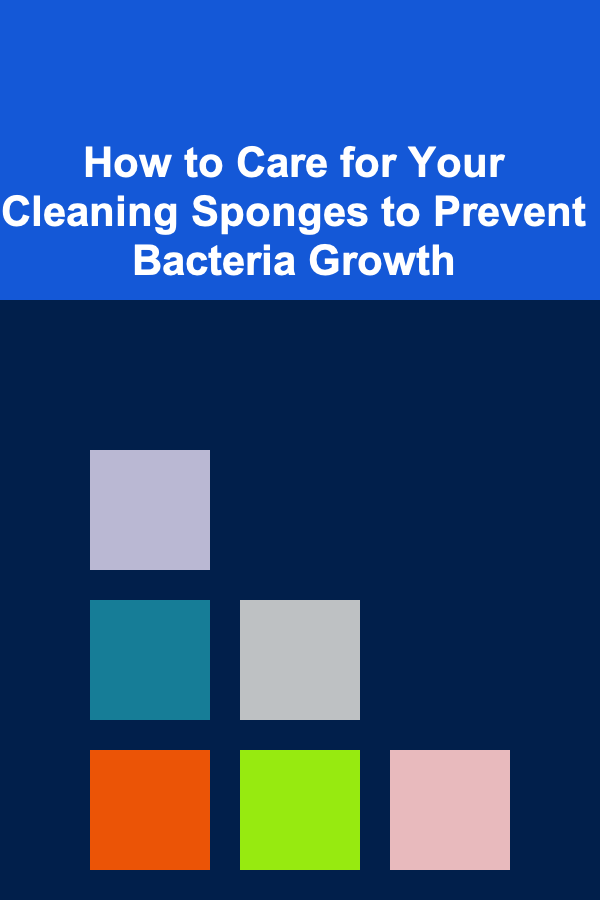
How to Care for Your Cleaning Sponges to Prevent Bacteria Growth
ebook include PDF & Audio bundle (Micro Guide)
$12.99$8.99
Limited Time Offer! Order within the next:

Cleaning sponges are ubiquitous in most households, indispensable tools for tackling dirty dishes, wiping countertops, and scrubbing surfaces. However, their porous structure and constant exposure to food particles and moisture make them a breeding ground for bacteria, potentially posing a health risk. Understanding how to properly care for your cleaning sponges is crucial to minimizing bacterial growth and ensuring a safer, healthier home environment. This article delves into the science behind sponge contamination, examines various cleaning and disinfecting methods, and provides practical tips for maintaining your sponges and extending their lifespan.
The Microbiology of the Cleaning Sponge: A Microbial Hotspot
The seemingly innocuous cleaning sponge is, at a microscopic level, a complex ecosystem teeming with bacteria. Studies have shown that a single sponge can harbor millions, even billions, of bacteria per cubic inch. This remarkable microbial density is due to the sponge's unique architecture, which provides a vast surface area for colonization. The interconnected pores offer protection from external stressors, such as heat and cleaning agents, while simultaneously trapping food particles, providing a constant source of nutrients for the bacteria.
While many of these bacteria are harmless, some species can be pathogenic, meaning they have the potential to cause disease. Common bacteria found in sponges include:
- E. coli (Escherichia coli): Certain strains of E. coli can cause food poisoning, characterized by symptoms such as diarrhea, abdominal cramps, and vomiting.
- Salmonella: Another common cause of food poisoning, Salmonella can lead to fever, diarrhea, and abdominal cramps.
- Staphylococcus aureus: This bacterium can cause skin infections, respiratory infections, and even food poisoning.
- Campylobacter: A leading cause of bacterial gastroenteritis, Campylobacter infection can result in diarrhea, abdominal pain, and fever.
- Klebsiella pneumoniae: This opportunistic pathogen can cause pneumonia, bloodstream infections, and urinary tract infections, particularly in individuals with weakened immune systems.
The presence of these bacteria in cleaning sponges highlights the importance of regular and effective cleaning and disinfection. Ignoring this aspect can lead to cross-contamination, transferring bacteria from the sponge to the surfaces you are trying to clean, ultimately increasing the risk of illness.
Factors Contributing to Bacterial Growth in Sponges
Several factors contribute to the rapid proliferation of bacteria within cleaning sponges:
- Moisture: Bacteria thrive in moist environments. The dampness of a sponge provides the ideal conditions for bacterial growth.
- Food Particles: Sponges frequently come into contact with food scraps and residues, providing a readily available food source for bacteria. Even tiny amounts of organic matter can fuel significant bacterial growth.
- Warmth: Warm temperatures further accelerate bacterial reproduction. Sponges left at room temperature provide an optimal environment for bacterial proliferation.
- Porous Structure: The sponge's porous structure creates a vast surface area, offering numerous sites for bacterial attachment and colonization. It also provides protection from disinfectants, making it difficult to eliminate all bacteria.
- Infrequent Cleaning: Lack of regular and effective cleaning allows bacteria to accumulate and multiply unchecked.
By understanding these contributing factors, you can take proactive steps to mitigate bacterial growth in your cleaning sponges.
Methods for Cleaning and Disinfecting Cleaning Sponges
Several methods can be used to clean and disinfect cleaning sponges, each with its own advantages and disadvantages. The effectiveness of each method depends on factors such as the type of sponge, the level of contamination, and the duration of the treatment. A combination of methods may be the most effective approach.
1. Microwaving
Microwaving is a popular and relatively effective method for disinfecting sponges. The high heat generated by the microwave kills many bacteria. Here's how to do it properly:
- Wet the sponge thoroughly: It's crucial to ensure the sponge is completely saturated with water. A dry sponge can catch fire in the microwave.
- Place the wet sponge in the microwave: Place the sponge on a microwave-safe plate or bowl.
- Microwave on high for 1-2 minutes: The exact time may vary depending on the wattage of your microwave. Start with 1 minute and check the sponge's temperature. It should be very hot to the touch (use caution when handling).
- Allow the sponge to cool: Let the sponge cool down before handling it to avoid burns.
Effectiveness: Studies have shown that microwaving can kill up to 99% of bacteria in sponges. However, some heat-resistant bacteria may survive. Important Note: Do not microwave sponges that contain metal or abrasive scrub pads, as this can damage your microwave or cause a fire.
2. Dishwasher
Running sponges through the dishwasher can also effectively disinfect them. The high heat and detergent action help to eliminate bacteria.
- Place the sponge in the dishwasher: Place the sponge on the top rack of the dishwasher to prevent it from melting or getting caught in the heating element.
- Run a normal wash cycle with a heated drying cycle: The heated drying cycle is crucial for killing bacteria.
Effectiveness: Dishwashing is generally effective at reducing bacterial load. However, it may not be as effective as microwaving for killing all types of bacteria. Combining dishwashing with another method can enhance disinfection.
3. Bleach Solution
Bleach is a powerful disinfectant that can effectively kill bacteria, viruses, and fungi. However, it's essential to use bleach safely and correctly.
- Prepare a bleach solution: Mix 3/4 cup of regular household bleach with 1 gallon of water.
- Soak the sponge in the bleach solution for 5 minutes: Ensure the sponge is completely submerged in the solution.
- Rinse the sponge thoroughly with clean water: Rinse the sponge until all traces of bleach are gone. Residual bleach can be harmful and irritating.
- Wring out excess water: Squeeze out as much water as possible.
Effectiveness: Bleach is highly effective at killing most bacteria and viruses. However, it can damage some types of sponges and may leave a residual odor. Important Note: Always wear gloves when handling bleach and avoid contact with your skin and eyes. Never mix bleach with ammonia or other cleaning products, as this can create toxic fumes.
4. Vinegar Solution
Vinegar is a natural disinfectant that is less harsh than bleach but still effective against some bacteria. White vinegar is the most commonly used type for cleaning.
- Prepare a vinegar solution: Mix equal parts white vinegar and water.
- Soak the sponge in the vinegar solution for 1 hour: Ensure the sponge is completely submerged.
- Rinse the sponge thoroughly with clean water: Rinse the sponge until the vinegar smell is gone.
- Wring out excess water: Squeeze out as much water as possible.
Effectiveness: Vinegar is effective against some bacteria, but it's not as potent as bleach. It's a good option for routine cleaning and deodorizing. It is also good at removing certain types of dirt and grime.
5. Boiling
Boiling is a simple and effective method for killing bacteria using high heat.
- Place the sponge in a pot of boiling water: Make sure the sponge is completely submerged.
- Boil for 10 minutes: Maintain a rolling boil for the entire duration.
- Carefully remove the sponge from the boiling water: Use tongs or a slotted spoon to avoid burns.
- Allow the sponge to cool: Let the sponge cool down before handling it.
- Wring out excess water: Squeeze out as much water as possible.
Effectiveness: Boiling is very effective at killing most bacteria and viruses. However, it can degrade the sponge more quickly than other methods.
6. Commercial Sponge Sanitizers
Several commercial sponge sanitizers are available on the market. These products are specifically formulated to kill bacteria and eliminate odors in sponges.
- Follow the manufacturer's instructions: Each product has its own specific instructions for use. Be sure to read and follow them carefully.
Effectiveness: The effectiveness of commercial sponge sanitizers varies depending on the product. Look for products that are EPA-registered and have been tested against a wide range of bacteria.
Practical Tips for Preventing Bacteria Growth in Sponges
In addition to regular cleaning and disinfecting, several practical tips can help prevent bacteria growth in your cleaning sponges:
- Rinse thoroughly after each use: After each use, rinse the sponge thoroughly under running water to remove food particles and debris.
- Squeeze out excess water: Wring out as much water as possible after rinsing. A drier sponge is less hospitable to bacteria.
- Store the sponge in a dry, well-ventilated area: Avoid leaving the sponge in a damp sink or on a wet surface. Use a sponge holder that allows for air circulation.
- Use separate sponges for different tasks: Use one sponge for dishes, another for countertops, and another for cleaning bathrooms. This prevents cross-contamination between different areas of your home.
- Replace sponges regularly: Even with regular cleaning and disinfection, sponges will eventually degrade and become more difficult to sanitize. Replace your sponges every 1-2 weeks, or sooner if they start to smell or show signs of wear and tear.
- Consider using alternative cleaning tools: Dishcloths, scrub brushes, and silicone sponges are less porous than traditional sponges and may be easier to keep clean. Dishcloths should be laundered frequently.
- Don't use sponges on raw meat or poultry: Use paper towels to clean up spills or messes from raw meat or poultry, as these items are often contaminated with Salmonella and other harmful bacteria. Discard the paper towels immediately.
- Air Dry Thoroughly: Allow your sponge to air dry completely after sanitizing. Place it in a location that allows for maximum air circulation.
- Educate your household: Ensure everyone in your household understands the importance of proper sponge hygiene and follows the recommended cleaning and disinfection practices.
The Importance of Rotation and Replacement
While cleaning and disinfecting can significantly reduce the bacterial load in sponges, it's important to acknowledge that these methods may not eliminate all bacteria completely. Over time, sponges can become increasingly difficult to sanitize due to the accumulation of organic matter and the development of biofilms (communities of bacteria that are highly resistant to disinfectants). Therefore, regular rotation and replacement of sponges are crucial.
Aim to replace your sponges every 1-2 weeks, even if they appear clean. If you notice any of the following signs, replace the sponge immediately:
- Foul odor: A persistent foul odor is a clear indication of bacterial growth.
- Visible discoloration: Discoloration can indicate the presence of mold or mildew.
- Deterioration: If the sponge is falling apart or losing its shape, it's time to replace it.
- Slippery Texture: A slippery texture is a sign of bacterial biofilm formation.
Consider keeping a supply of clean sponges on hand so that you can easily replace them as needed. Establishing a regular replacement schedule will help ensure that you are always using a clean and hygienic cleaning tool.
Alternative Cleaning Tools: Are Sponges Necessary?
Given the challenges associated with keeping sponges clean, it's worth considering alternative cleaning tools. While sponges are convenient and versatile, other options may be more hygienic and easier to maintain.
- Dishcloths: Dishcloths can be laundered in a washing machine with hot water and detergent, effectively killing bacteria. However, it's important to use a fresh dishcloth for each cleaning task and to launder them frequently (ideally daily).
- Scrub brushes: Scrub brushes are less porous than sponges and can be easier to clean. Many scrub brushes are dishwasher-safe, allowing for thorough sanitization.
- Silicone sponges: Silicone sponges are non-porous and can be easily cleaned in the dishwasher or with hot soapy water. They are also more durable than traditional sponges and can last longer.
- Microfiber cloths: Microfiber cloths are highly absorbent and effective at removing dirt and grime. They can be laundered in a washing machine and reused.
Ultimately, the best cleaning tool for you will depend on your personal preferences and cleaning habits. However, it's important to be aware of the potential risks associated with sponges and to choose cleaning tools that are easy to clean and maintain.
Conclusion: A Proactive Approach to Sponge Hygiene
Cleaning sponges are essential tools for maintaining a clean and healthy home, but their inherent susceptibility to bacterial contamination necessitates a proactive approach to hygiene. By understanding the factors that contribute to bacterial growth, implementing effective cleaning and disinfection methods, and adopting practical preventative measures, you can significantly reduce the risk of cross-contamination and protect your family from potential health hazards. Remember that consistent effort and attention to detail are key to maintaining sponge hygiene and ensuring a safer, cleaner living environment. Whether you choose to microwave, dishwash, bleach, or embrace alternative cleaning tools, prioritizing sponge care is an investment in your health and well-being. This involves regular sanitation, proper storage, and knowing when it's time to replace your sponge. By adopting these practices, you can minimize the risk of bacteria and keep your cleaning routine both effective and safe.
Reading More From Our Other Websites
- [Personal Care Tips 101] How to Layer Body Spray with Other Fragrances
- [Toy Making Tip 101] Interactive Storytelling Toys: Crafting Playsets That Change with the Narrative
- [Personal Finance Management 101] How to Save Money on Home Repairs with DIY Solutions
- [Personal Care Tips 101] How to Choose Lip Gloss with Nourishing Oils for Soft Lips
- [Toy Making Tip 101] From Fabric to Figurine: A Beginner's Guide to Crafting Your First Doll
- [Home Soundproofing 101] How to Soundproof a Garage for Music or Hobbies
- [Organization Tip 101] How to Reflect on Your Wellness Goals Through Space Design
- [Home Cleaning 101] How to Clean Your Air Ducts and Improve Air Quality
- [Small Business 101] Entrepreneur Tips: Avoiding Common Mistakes in Your First Year
- [Home Maintenance 101] How to Prepare for a Home Inspection: Tips and Tricks

How to Set Up an Emergency Fund for Your Home
Read More
Turning Hobbies into Careers: Exploring Passion Projects
Read More
How To Understand the Cultural Significance of Colors
Read More
How To Celebrate Holidays in a New Culture
Read More
How to Model Realistic Fabric in Blender
Read More
How to Evaluate a Personal Finance Planner's Investment Strategy
Read MoreOther Products

How to Set Up an Emergency Fund for Your Home
Read More
Turning Hobbies into Careers: Exploring Passion Projects
Read More
How To Understand the Cultural Significance of Colors
Read More
How To Celebrate Holidays in a New Culture
Read More
How to Model Realistic Fabric in Blender
Read More